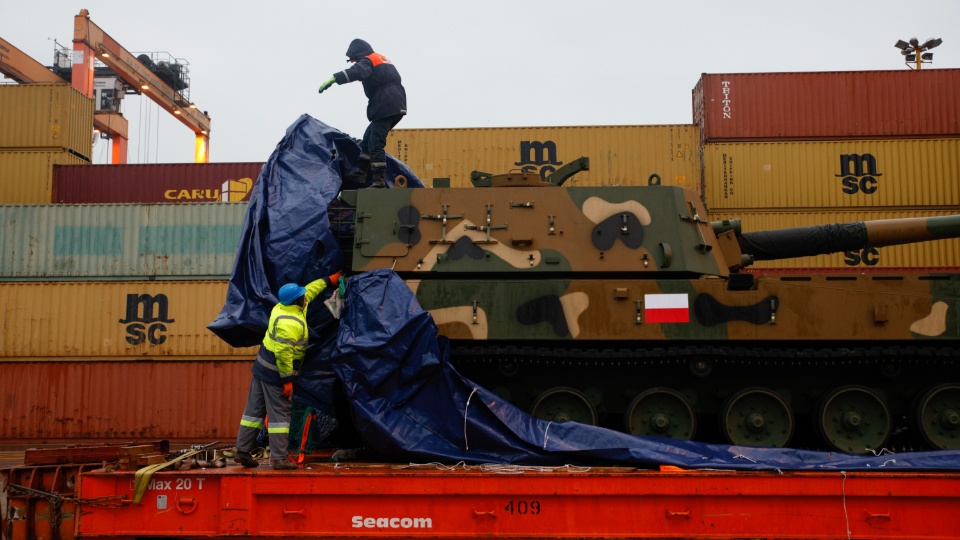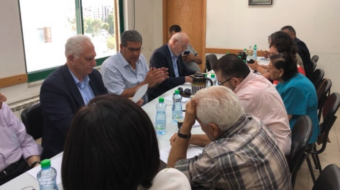
Poland’s Law and Justice Party, since it took control, has banned abortion rights, limited other women’s health care, attacked LGBTQ rights, banned opposition political groups, shut down numerous trade union locals, instituted education policies that make Ron DeSantis’ policies in Florida look mild, installed its own right-wing judges in the courts, attacked all religious groups except the Roman Catholic Church, given the OK to people who want to steal any property held by the Romani minority in the country (with the argument that the Romani, who have been in Poland for centuries, have no rights), and sealed off the borders to people of color trying to enter the country.
Those are just some highlights among many other repressive policies instituted over the years by the party founded by twin brother politicians Jarosław and Lech Kaczyński.
Polls show that the ruling party, now led by Andrzej Duda, is in danger of losing the coming parliamentary elections on Oct.15. In an attempt to prevent that from happening, the government has resorted for the past month to a major campaign to convince the Polish people that their security is in danger, specifically from Russia and its Wagner mercenary group.
(Duda’s government might have to moderate that campaign now that it appears President Vladimir Putin may have killed Yevgeny Prigozhin and much of the rest of the Wagner leadership with the downing of an airplane that took off Wednesday from Moscow. Prigozhin and Wagner spearheaded an aborted armed rebellion against Putin in June; the Russian leader has now likely gotten his revenge.)
The Polish government has a major advantage in its anti-Russia campaign though, because, like their Hungarian fascist neighbors to the south led by Viktor Orban, they have taken over most of the major newspapers, the internet is tightly managed, and most of the television news outlets toe the line given by the state. The Law and Justice propaganda apparatus has been using all these tools to spew right-wing propaganda claims that Poland is about to be invaded by Putin, using either the regular Russian army or the Wagner mercenaries to do the job.
Even the New York Times—which since the Russians invaded Ukraine last year has been portraying Poland as a bastion of democracy that can be counted on to help NATO fight against Putin and for democracy in Ukraine—recently published an article showing how this right-wing Polish scare campaign has taken shape in a section of the country called the Suwałki Gap.

The area is a border zone near the intersection of Poland, Belarus, Lithuania, and Kaliningrad, the Baltic Sea Russian enclave separated from the rest of mainland Russia. It is from Kaliningrad, allegedly, that the invasion of Polish territory is, according to the Polish fascists, supposed to come.
Happily, there are a few newspapers left in Poland that have not been taken over by the Law and Justice Party. One of those is a local Suwałki news outlet whose editor is Wojciech Drazba. It is his region of beautiful countryside and small towns that constitute the Suwałki Gap on which the Polish government, because of its geopolitical location, is concentrating its fear campaign.
Drazba has been pointing out for more than three weeks now, online and in newspaper interviews, including one with the New York Times, that there has never been any sign of the Wagner group or regular Russian troops anywhere in the area. In fact, he says, any Russians and Wagner forces in Belarus as a whole have been leaving that country and going back to Russia.
Unlawful and unjust
The danger his area and Poland as a whole face now is not from Russia but rather from the leaders of the ruling Law and Justice Party, Drazba says. They are running Poland “from the parallel universe in which they live,” posing as “muscular defenders of Polish national security” as the election nears, he says. “The sun is shining, the scenery is beautiful, and absolutely nothing is happening,” he tells newspaper reporters and others who call him.
Yet the right-wing-controlled press in Poland is describing an entirely different situation in the Suwałki Gap, with the leading government newspaper and TV station saying “It is the most dangerous place on Earth.” Absolutely no evidence of that claim is offered.
The Polish government has been a strong supporter of Ukraine’s resistance to the Russian invasion. It pretends that its concerns are humanitarian in nature and supportive of democracy in Ukraine. Those claims are ringing hollow with growing numbers of Poles, however, who see and feel daily the effects of the very un-humanitarian policies of the Law and Justice Party. Millions are beginning to see government claims of imminent danger in the Suwałki Gap as political manipulation, as an attempt to improve the ruling party’s chances of winning the next election.
The use of Poland as a transit point for many billions of dollars worth of NATO weapons, traversing from west to east across the country, is generating a lot of money for certain well-connected Polish oligarchs. It is essentially impossible to estimate the enormous amounts of cash being skimmed off the top by the oligarchs, Poland’s own arms dealers, and well-positioned leaders of the Law and Justice Party.
Poland, as a member of NATO, has become one of the largest purveyors of arms transport in the world, with major armament manufacturers in the West (and U.S. taxpayers) paying hefty sums to the right-wing government and local corporations for the privilege of using Poland as a weapons logistics hub.
Those powerful forces in Poland and all over NATO are pouring money into the re-election campaigns of Law and Justice Party parliamentarians. It is no exaggeration to say that without Poland, the entire U.S. and NATO policy, not just in Ukraine, but in NATO’s encroachment up to the borders of Russia, in violation of promises not to do that, would have been impossible.
The tight relationship between the arms profiteers in Poland and the Pentagon is truly scandalous, with Poland rewarding its partners in crime with the ability to station nuclear missiles on its soil. When President Joe Biden went to Poland last year, he did not talk about all the violations of democratic values underway in Poland. Instead, he praised Poland as a “democracy” and thanked the country’s leaders for taking in millions of Ukrainian refugees, something they did to curry even more favor with the U.S. and NATO. (Of course, only light-skinned refugees were allowed to step foot in Poland.) Many of the migrants who came moved on to Germany or later returned to Ukraine.
As for the residents of the Suwałki Gap who actually live on the border, they expect to be hit with more and more nationalist propaganda between now and the October elections. And to ensure the re-election of their neo-fascist political allies in Warsaw, NATO officials apparently have no problem joining Law and Justice politicians in trips to the Suwałki Gap to talk up the supposed threat of a Russian invasion.
Recently, Polish Prime Minister Mateusz Morawiecki went there with Lithuanian President Gitanas Nausėda. An elaborate set-up was constructed for the television cameras showing the two leaders examining alleged military maps of the area spread out on a big table and talking about non-existent invasion scenarios coming from Russia. The message was that keeping the right-wingers in charge in Warsaw and Vilnius is the only way Poland can be protected.
Exposing what the visit was really all about, the two leaders launched verbal attacks on the opposition parties for being “soft” on Polish security and downplaying the risk of Russian or Wagner Group attacks.
“These threats are real,” Morawiecki insisted, even as no Russian troops were anywhere near the Polish border and the few left in Belarus were withdrawing back to Russia.
Stoking the fascist flames
If the security sham isn’t enough, just a week ago, Law and Justice pulled out another trick to scare voters and gin up votes. It involves putting policy questions on the ballot aimed at riling up conservative right-wing voters.
Is anyone in favor of accepting illegal migrants, lowering border defenses, selling off state companies, and making people work longer before they retire? These are some of the questions on the ballot along with a statement next to each one that anyone backing these ideas should vote for the opposition parties and not the ruling Law and Justice Party.
The so-called referenda will be held together with the parliamentary election.

The questions and the way they’re phrased are, of course, not serious legislative ideas. Rather, they’re designed to cause problems for the opposition and make it easier for the right-wing nationalists to win a third term. It allows the ruling party to scoop up more public funds for its overall electoral efforts on the grounds that more things on the ballot require more campaign funds. In a holdover from better, more progressive days in Poland, there is public funding of election campaigns, a larger share of which, the ruling party wants to control.
“It’s just another method to appropriate public funds to finance an election campaign basically without any limits,” Agnieszka Dziemianowicz-Bąk, an MP for the opposition Left Party, told Polsat News last week.
Law and Justice and the state-controlled media that back it have been claiming that the opposition will compromise Poland’s security and economic development if it wins power. They sling the accusation that the opposition is made up of people who are not “loyal Poles.”
“We have had more than enough of this nonsense,” the mayor of one town in eastern Poland, Augostow, told the press last week. “Why is everyone talking about threats all the time? There are no tanks on the streets or soldiers with automatic weapons. The towns here are among the safest places in the world.”
People’s World reached a member of the town council by telephone who said, “Proof of the craziness of the scare tactics of the Law and Justice Party is that Poland is a part of NATO, which means that if something happened here with Russians attacking there would be a big war all over Europe and maybe even the world.”
He recalled that Poles were told when the country joined NATO they would be safe. “Now that is not enough, we are supposed to give in to scare messages and vote for the ruling party so the rulers win the next election.” The councilor asked that his name not be used, saying, “You can get in trouble in Poland if you say too much.”
Angering locals with recycled lies
Really angering the locals now is that Law and Justice, posing as the only reliable protector of Polish security, has announced it will dispatch thousands of Polish troops into the Gap to “protect” the same people who are saying they don’t need protecting. If the government follows through on the pledge, members of the military could very well outnumber civilians in the area. The nearness of Kaliningrad, the Russian enclave, is again being used as justification.
Even the term “Suwałki Gap” that the government media uses to describe the area is a creation of a right-wing effort to justify NATO expansion. The Times reported that the term Suwałki Gap was first coined in 2015 by Toomas Hendrick Ilves, the then-president of Estonia. What the Times did not say is that he advocated and carried out the tearing-down of memorials to Estonians who fought back against the Nazis in World War II. Those Estonians worked with the Soviet Union to rid their country of Hitler’s invading army.
Ilves also supported making the Communist Party illegal and instituted many discriminatory measures against the 40% of the Estonian population that is ethnically Russian. His anti-Russian bent was exposed long before the invasion of Ukraine last year.
In any case, he said he came up with the term just before he met with the defense minister of Germany. The purpose of that meeting was to get Germany on board with the idea of stationing NATO troops in the Baltic states.
He was reimagining a thing called the “Fulda Gap,” a strip of territory between West and East Germany during the Cold War. Right-wingers in West Germany used fear of the Fulda Gap to get more and more funding for their military on the grounds that the “Fulda Gap” was a vulnerable spot through which the Soviet Union could launch an attack on West Germany.
The German Defense Minister at the time of the meeting was Ursula von Der Leyen, now the president of the European Union. She long held anti-Russian views and after that meeting presided over the deployment of large numbers of German troops under the flag of NATO to the Baltic states. To many older citizens of those countries, it must have seemed like a re-enactment of the Nazi armies on the way to besiege Leningrad, where millions were killed during World War II. Many were unhappy to see German tanks and, later, American tanks rumbling through Lithuanian, Estonian, and Latvian towns.
German rightists and right-wingers in the Baltic states then worked closely together to provide impetus for the NATO expansion right up to the borders of Russia, using the notion that there was another troublesome “Gap” the Russians could use to invade the West. No such use by the Russians of the Fulda Gap back during the Cold War or the Suwałki Gap these days has ever occurred.
Cold Warriors, however, never seem to give up their penchant for military provocation. An essay published last week by the Atlantic Council in Washington D.C. urged that NATO stage major maneuvers in the Suwałki Gap to “show the Russians that the West does not fear conflict with Russia.”
Impossible invasion
As the October elections draw near, the Polish government is ramping up the scare stories across the entire country. The main TV channel, TVP (Television Poland), is the most-watched station in the country and is under total government control. Every day, its anchors and commentators discuss new, non-existent threats coming from Belarus and Russia, even as people know that any Russian attack would be met with armed retaliation by NATO.

Several retired Polish generals, according to the Times, have added their voices to those who say the government claims are nothing but propaganda designed to gin up votes. A number of retired Lithuanian generals have done the same.
“There really is no such threat,” a Lithuanian general was quoted in several German newspapers as saying. Like the town councilor in Augostow, he declined to reveal his name because people like him can suffer retaliation in Lithuania and Poland these days.
Other generals have noted that alleged threats from Kaliningrad are particularly absurd since the Russian enclave is totally surrounded by NATO member states on all sides. Boxing in Kaliningrad was, of course, a major reason that NATO wanted to expand into the Baltic states in the first place. The threat in the area, if any exists, is to Kaliningrad rather than to Poland.
The opposition parties in Poland—left and center both—have an uphill battle to make the October elections be about real issues, to get voters focused on topics other than the ruling party’s fabricated security threats and fake populist referenda questions. They know what they’re up against.
Jacek Niedzwiedzki, the deputy head of Suwałki’s town council, is an opposition candidate for parliament on the list of the centrist Civic Coalition party. “Law and Order is hiking up the fear level in order to gain support in the election,” he said online recently. “We have to improve living conditions in Poland, not just build up fear of things that are not going to happen.”
We hope you appreciated this article. At People’s World, we believe news and information should be free and accessible to all, but we need your help. Our journalism is free of corporate influence and paywalls because we are totally reader-supported. Only you, our readers and supporters, make this possible. If you enjoy reading People’s World and the stories we bring you, please support our work by donating or becoming a monthly sustainer today. Thank you!












Comments